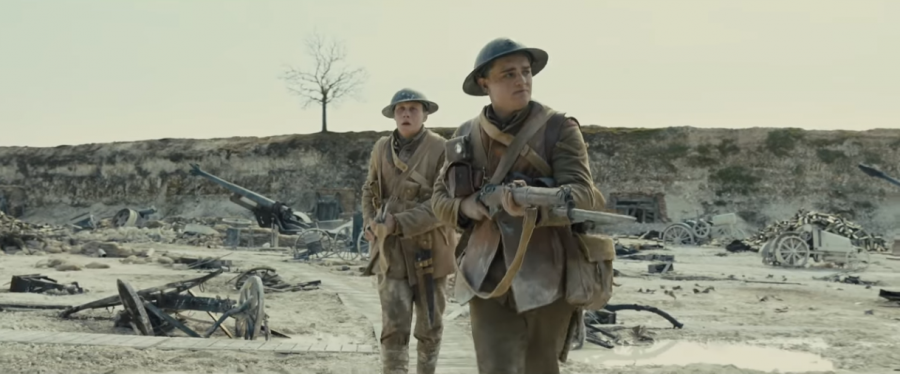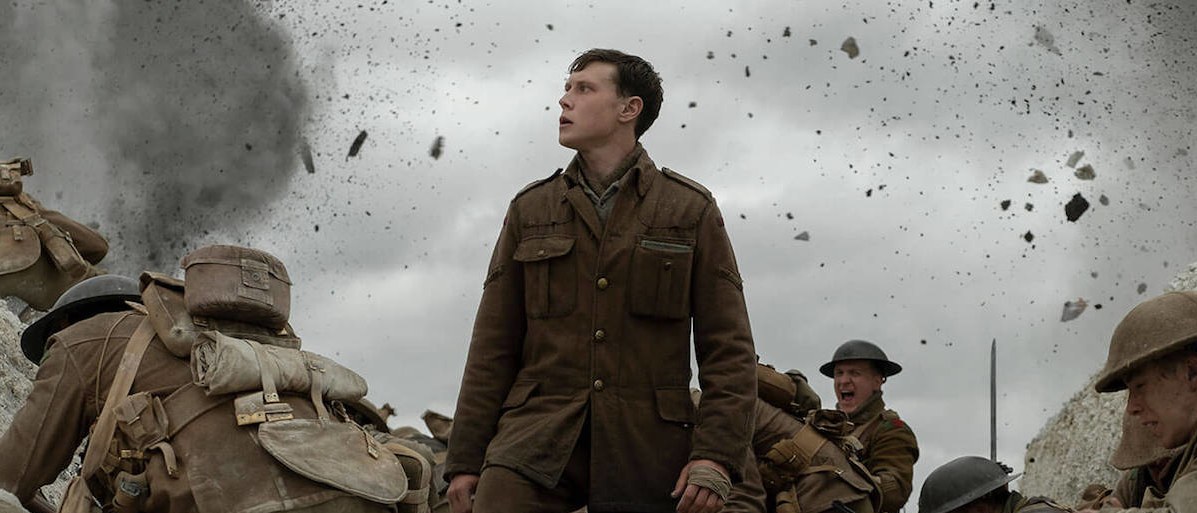Movie Review: 1917
February 21, 2020
World War I is famous as the war that changed the nature of combat. During the war, new, deadlier technology forced troops from both sides to engage primarily in trench warfare rather than the direct conflict that’d been standard for decades, causing indirect fighting for weeks over miniscule advances in territory. Compared to other wars, it’s characterized by a general sense of a lack of purpose or advancement, a war brought about by rampant militarism and alliances that dragged much of the world into the conflict of two nations.
1917 conveys this lack of direct combat well, but throughout the film it feels more like an exemplification of the cinematographer’s skills than a story with depth or memorable characters.
1917 received widely positive reviews from critics, winning Best Picture in the Golden Globes, multiple Academy Awards and seven awards from the British Academy of Film and Television Arts. Its cinematographer, Roger Deakins, is one of the most accomplished cinematographers in British film, having received awards in the past for his work on Blade Runner 2049, Skyfall and The Shawshank Redemption. His latest film continues his legacy in an impressive technical feat–for much of the film, the camera seems to follow the two main actors in a singular unbroken shot.

The film follows the story of two soldiers, Schofield (George MacKay) and Blake (Dean Charles-Chapman) as they attempt to carry a message from a British trench to another regiment, traversing dangerous territory and ruined buildings in the process. It starts out slow, setting up the journey as Schofield and Blake walk through the trenches. For the first half of the film, the cameras follow close behind the two, seemingly never cutting away, as they make their way out and up into No Man’s Land, the highly dangerous zone of open field between opposing trenches.
The film’s storyline, however, lacks in any real sense of characterization or realism for much of the first hour. Schofield and Blake exchange comments as they walk, occasionally stumbling upon abandoned buildings or the bodies of soldiers left in No Man’s Land. Despite the long period of time they have to speak, we know very little about the characters besides their objective–reach the other regiment and prevent them from carrying out an attack. The film rapidly switches focus from the horrors of war to the more peaceful moments, but the one-shot approach makes the timing of certain moments in the film feel unrealistic.
1917’s real achievement is in the second half of the film, when MacKay enters a war-torn German-occupied city. The cuts here are shorter and more obvious, but the scene makes up for it with fantastic set design and lighting. In one of the most visually striking scenes of the entire movie, Schofield steps out into a street engulfed by flames, dazed after an exhausting journey to the city, and stares into the blaze as a German soldier emerges from the smoke.

Despite the initial slow pace of the film, Mendes says that the lack of intense action typical of some war movies was a goal, not a failure.
“I took a calculated gamble, and I’m pleased I did because of the energy you get just from driving forward (in the narrative), in a war that was fundamentally about paralysis and stasis,” he said in an interview with Time Magazine.
Mendes’ inspiration for the film came from his grandfather’s stories of aiding the British during World War I. Mendes’ grandfather, Alfred Mendes, was the son of a Portuguese immigrant to Trinidad and Tobago and an author of several books during the 1930s. He served as a messenger for the British in Belgium from 1915 until the end of the war, sometimes having to traverse the so-called “No Man’s Land” to bring messages to the British. Elements of his stories are evident in several parts of the movie.
All in all, 1917 is a beautiful display of “one-shot” cinematography, but it lacked the kind of compelling storyline that makes movies memorable. The film stands out most for the dedicated planning of the cinematographers and actors in creating a movie that carefully utilizes lighting, practical effects and timing down to the second.
1917 is currently showing at Bowling Green’s Great Escape Theater and Greenwood Mall’s Regal Theater. It is rated R for language and war violence.

Jayme Silvestri • Oct 2, 2021 at 12:44 am
I’ve been browsing online more than three hours today, yet I never found any interesting article like yours. It’s pretty worth enough for me. Personally, if all website owners and bloggers made good content as you did, the internet will be a lot more useful than ever before
Jayme Silvestri